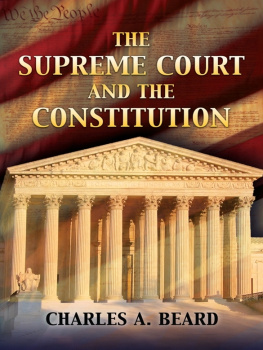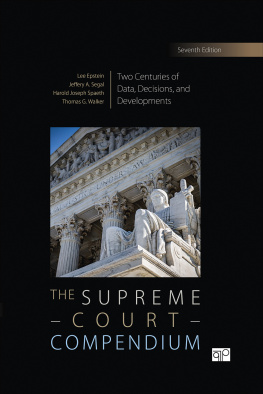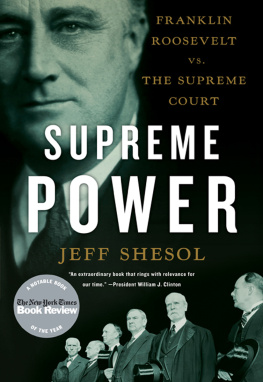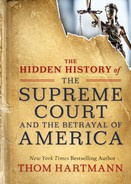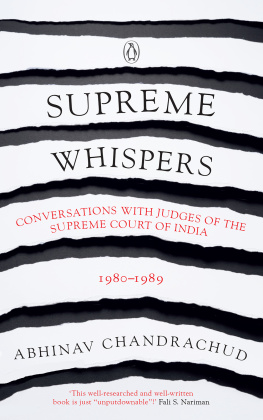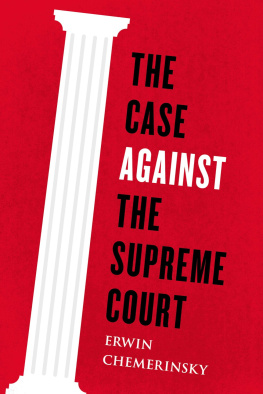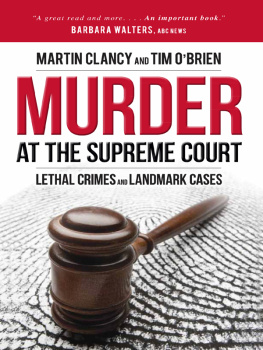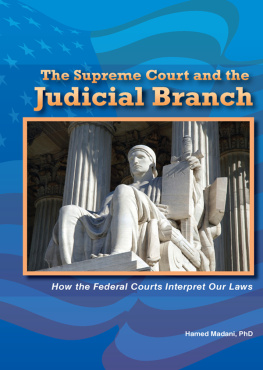University of Virginia Press
2010 by the Rector and Visitors of the University of Virginia
All rights reserved
Printed in the United States of America on acid-free paper
First published 2010
9 8 7 6 5 4 3 2 1
LIBRARY OF CONGRESS CATALOGING-IN-PUBLICATION DATA
Sweet, Martin J., 1970
Merely judgment : ignoring, evading, and trumping the Supreme Court /
Martin J. Sweet.
p. cm. (Constitutionalism and democracy)
Includes bibliographical references and index.
ISBN 978-0-8139-3058-9 (cloth : alk. paper) ISBN 978-0-8139-3077-0 (e-book)
1. Civil rightsUnited States. 2. Constitutional lawUnited States.
3. United States. Supreme Court. 4. JudgmentsUnited States. 5. Obedience
(Law)United States. 6. Affirmative action programsUnited States. I. Title.
KF4749.S93 2010
342.7308'5dc22
2010012581
ACKNOWLEDGMENTS
This project, which began in earnest more than a decade ago, could not have been accomplished without the assistance and support of many individuals and organizations. Some of the individuals were intimately involved as the work developed, reading, editing, raising questions, challenging me, and encouraging me to pursue new lines of argument and evidence. I am particularly grateful to my dissertation committee members, the 2004 and 2005 Edward S. Corwin Prize committee members, the Constitutionalism and Democracy series editors, anonymous reviewers of this work for the press, and the editorial team at the University of Virginia Press. Many other friends and not so friendly interlocutors at lectures and conferences have had a less direct but no less important effect. In fact, some of the most cogent criticism I received came in the form of offhand acerbic remarks that I did not fully appreciate at the time. With the benefit of time, I am exceptionally proud to be part of an academy that prizes the value and practice of free speech, evenperhaps especiallywhen such language might be slightly painful to hear.
John Witte, Don Downs, David Canon, and Ken Mayer served on my dissertation committee at the University of WisconsinMadison, and I benefited from their unique strengths and talents. In 1997, when this project was first formulated, I conceptualized the issue of the value of affirmative action as one ultimately grounded in political theory. I continued to explore the legal and theoretical issues under Don Downs, but I also began to pursue the institutional dimensions of this issue, in the course of which I learned a great deal from both David Canon and Ken Mayer. A critical piece to the puzzle was added when I became fully engaged in policy studies with John Witte. While I was always given guidance and helpful suggestions, these four outstanding scholars never once attempted to make the work anything different from what I envisioned or pursued. Each pushed and prodded, but in the end, they gave me the freedom to flourish or fail on my own.
The University of WisconsinMadison, Florida Atlantic University, Clara Penniman and the University of Wisconsin Distinguished Graduate Fellowship, the Institute for Legal Studies, the Wisconsin Policy Research Institute, Dickinson College, the Centennial Center at the American Political Science Association, the Faculty Colloquium in Public Law at Princeton University, the University of Haifa Faculty of Law, the University of Haifa School of Political Science, and the Honors College of Florida Atlantic University provided financial and other support for my work. To those institutions and the individuals who form them, I am very grateful. As well, I appreciate the assistance I received in conceptualizing ideas, tracking down sources, and refining my thought from many others, including Booth Fowler, Charles Franklin, Marc Galanter, Evan Gerstmann, Howard Gillman, Mark Graber, Roger Hartley, Tom Keck, Mark Kessler, Bert Kritzer, Susan Lawrence, Dan Lipson, Michael McCann, Terri Peretti, Mitch Pickerill, Harry Pohlman, john a. powell, John Ransom, Andy Rudalevige, Howard Schweber, Tim Steigenga, Keith Whittington, and especially Chuck Epp and Dan Farber. Both Chuck and Dan fostered my love of politics and law and have long tolerated my ideas and idiosyncrasies, traits that won them their titles of teachers and colleagues.
I would also like to thank the editorial team and series editors at the University of Virginia Press. Dick Holway, Raennah Mitchell, Mark Mones, Morgan Myers, Marjorie Pannell, Gregg Ivers, and Kevin McGuire guided me exceptionally well through the publication labyrinth.
Special mention must be made of two people, Don Downs and Anat Hakim, both of whom know they have my eternal gratitude but nevertheless deserve public accolades. Don, whom I have already mentioned, was the primary reason I entered the academy. When I was an undergraduate in the fall semester of 1989, I watched him command a rapt student audience in 165 Bascom. Returning to Madison to teach and learn formally from Downs and others largely pales in comparison with the education I received and continue to receive from Downs over a drink, during a football game, in Independence Hall, at a fancy dinner, or over the phone. And it is with great pride that I formally thank my wife, Anat. This project would not have been finished without her assistance. Her love and support have simply made all of my dreams come true. May our children, Elli, Solomon, and Leo, learn this lesson from uschase your dreams.
Some material in this book previously appeared in another publication and is reproduced here with slight changes by permission of the publisher: Minority Business Enterprise Programmes in the United States of America: An Empirical Investigation, Affirmative Action Symposium, Journal of Law and Society 33, no. 1 (2006): 16080.
INTRODUCTION
The judiciarymay truly be said to have neither FORCE nor WILL, but merely judgment.
Alexander Hamilton, Federalist 78.
In 1983, a dispute over a fairly small contract to install fixtures in a city jail began that would end years later by placing the U.S. Supreme Court at the center of the nation's affirmative action policies.
This book explores the question of what happens after the Supreme Court decides a case. After the legislation, litigation, and judicial decisions have settled, what then? How are these judicial decisions interpreted and implemented? What is the concrete impact of these sometimes abstract legal decisions? The lessons learned from exposing the contingent nature of the effects of judicial decision making then serve as the basis for constructing a normative view of constitutional interpretation and the relationship between the courts and the elected branches of government. As I find that political institutions enjoy considerable discretion in deciding whether and how to follow judicial decisions, largely because of their ability to defang would-be plaintiffs, I argue for a concept of judicial primacy that would better protect individuals in their enjoyment of constitutional rights.
Promise and Reality
Following the Supreme Court's ruling in Croson, Richmond would abandon its affirmative action program and the J. A. Croson Company would no longer be subject to the minority set-aside requirement in competing for government contracts. This legal standard is known as strict scrutiny.




